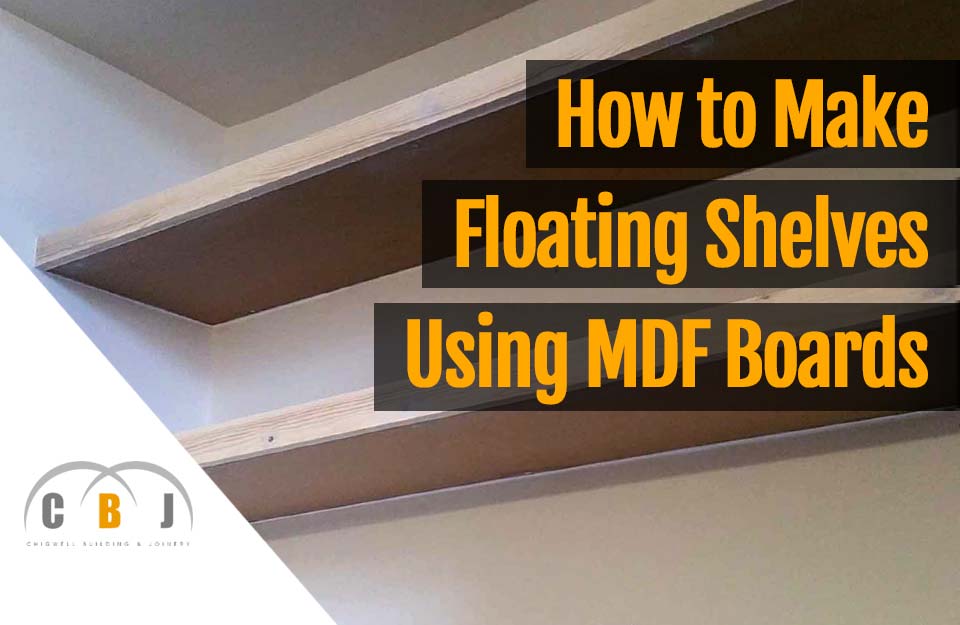
How to Make Floating Shelves Using MDF Boards
Author Chigwell Building & Joinery
Date 08/11/19
Most households tend to have one thing in common – not enough storage space!
There's just too many items to store into cupboards and closets and consequently, untidy piles of items start to accumulate in all the wrong places.
For those who are keen to keep everything organised and out of sight, practical storage solutions are a must.
For this reason, floating shelves are a godsend.
They can help to alleviate this problem without breaking the bank, without taking up additional floor space, which more often than not tends to be very limited.
Building your own floating shelves is fairly straightforward, and even a beginner in DIY can do a great job.
Here are some guidelines on how to go about making floating shelves using MDF boards, which are practical and affordable.
Read on to find learn more, or use a jump link below to skip to a desired chapter:
Chapters
What You Will Need
You will need basic tools and supplies which will easily be found in any hardware store, including:
- Hammer Drill
- Screwdriver
- Wall Plugs & Screws
- MDF Boards
- Support Timbers
- Tape Measure
- Sandpaper
- Spirit Level
- Paint (optional)
Some of these may be substituted for other tools as may be noted hereunder.
Building the Floating Shelves
Step 1: Planning & Measuring
Start by measuring the space where you intend to install your shelves.
Consider what you will be placing on them so as to decide the space you should leave between one shelf and another.
This is important so that you won’t end up with unutilised wall space, and you would be maximising your storage space on the shelves.
Based on this, you can then calculate how many shelves can fit in that wall space, and their sizes.
Mark the top line of each shelf with a spirit level, and take note of the items you will need based on the number of shelves you will be making.
Bear in mind that for each shelf you will be needing two support timbers for the length and the width of the shelf, and obviously an MDF board in the desired size.
Step 2: Gathering Supplies
Next start gathering the supplies and the tools you will be needing.
As you may see from the list above there are no particularly costly tools and supplies can easily be gathered.
Step 3: Cutting
Supporting timber pieces are important as they will make your project safer and sturdier.
Each shelf will need four pieces, one on each side, and if you wish an additional one in the middle to provide extra support.
This is especially important if you will be placing rather heavy items on the shelf.
Cut your timber pieces according to the number of shelves you decided to build.
MDF boards will probably have been cut for you at the store where you bought them, so there is no need to worry about getting them.
Step 4: Attaching the Support Structure
Floating shelves are best built with a support structure.
The top of this structure should be in line with the top of the upper shelf.
Start by screwing the first part to the back wall of the alcove, always making sure that it is level.
Next start to fit the sides, and finally the front strip will be attached.
It is a good idea to pre-drill the holes in the timber as this will help to avoid any splitting or countersinking.
This process will need to be repeated for each shelf.
Think of this as the frame for your floating shelves.
Step 5: Final Fitting
Then fit the shelf cladding by screwing the bottom cover of the shelf to the supporting structure.
Place the top parts over and screw them for additional safety.
Finally screw the front panels to the shelves.
Step 6: Painting the Shelves
A coating of paint is optional.
Some people opt for this so as to have the shelves complement the rest of the furniture in the room where they are installed.
Others may stick to the natural look of MDF.
In any case make sure to fill in any holes and sand lightly so as to make your shelves look smooth and finished off nicely.
Helpful Tips & Ideas
Since it is a good idea to measure the angles at the sides and the back in relation to the front, it is a good idea to have an adjustable square at hand.
This will ensure more accuracy and ultimately a neater result.
Use the machined edge of the MDF board first as this will be flush to the front batten.
There are different thicknesses of MDF sheets that you could buy.
There is no need to go for really thick ones unless you are going to place considerably heavy items on the shelves.
You might wish to enquire which thickness is most suitable before buying.
It is really helpful to use the top sheet for each shelf as a template for the bottom one.
Attaching the boards to the battens can be done by glue and clamping or by using a nail gun.
Clear any excess and fill in any gaps by using some decorator’s caulk.
This will make things neater.
In the case of any countersunk screws, particularly at the front of the shelves, you can use some filler to hide them off.
Then sand lightly to make it smoother and more flush.
Alternatively, you might wish to attach pine strips to that thickness so as to cover off any defects more neatly.
If you opt for painting the shelves always sand them first.
Keep some wall paint at hand so as to touch up any parts which might have ended up marked while you were installing the floating shelves.
Conclusion
And that’s it!
As you can see it is a really effortless and fairly simple project to build your own floating shelves.
Next start piling them up with that stuff that you had in mind so as to put them to good use!

